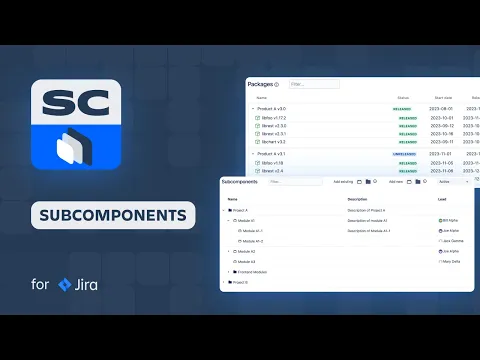Subcomponents for Jira
Additional time may be available from the app vendor.
About Data Center trials
OVERALL RATINGS
INSTALLS
245
SUPPORT
- Partner Supported
Key highlights of the appExtend projects with Subcomponents, Component Versions, Packages, Component and Version custom properties

Split and rule a project with Subcomponents
Convert project components into a meaningful hierarchy.
Enable users to select components from the hierarchy in issues including Customer Portal.
Find issues and create reports based on subcomponents hierarchy.
Release components independently with Versions
Organize and manage release roadmap on a component level.
Different teams can develop and release different components in one project.
Filter and group versions by issue components when editing any issue Version fields.
Group versions into Packages
Organize and track multiple versions as a single product release
Find all packages where an issue is implemented using Packages issue panel
Search issues and create reports based on packages with packageVersions() JQL
Supporting media
More details
Sandbox Jira | Documentation | Support
Subcomponents app implements the following missing parts of Jira projects functionality:
- Subcomponents - extend components with subcomponents hierarchy
- Component versions - link versions to components to make them releasable
- Packages - group system versions into a product release
- Component properties - add more details to components + componentProps() JQL search
- Version properties - add more details to versions + versionProps() JQL search
- Global settings - enable extensions for projects types
- Custom permissions - delegate manage extensions to non-project admin users
- Public REST API - create integrations, pull and post data from/to extensions
- Public Java API - interact with app programmatically
Resources
Download
Get the .jar file downloaded to your system
App documentation
Comprehensive set of documentation from the partner on how this app works
Privacy and Security
Privacy policy
Atlassian's privacy policy is not applicable to the use of this app. Please refer to the privacy policy provided by this app's partner.
Partner privacy policySecurity program
This app is not part of the Marketplace Bug Bounty program.
Version information
Version 3.14.1•for Jira Data Center 8.20.0 - 10.7.1
- Release date
- Jun 18th 2025
- Summary
- Fix package description not being saved during package update
- Details
- Payment model
- Paid via Atlassian
